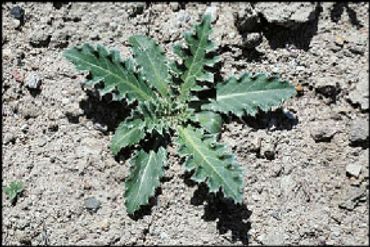Musk Thistle






Details and Information
Common Names
Nodding thistle
Description
Musk thistle is a biennial or winter annual that can grow up to 8 feet tall. The leaves of Musk thistle are deeply lobed, hairless and are dark green with a light green mid-rib. A silver gray leaf margin is a characteristic of each spine tipped lobe. The leaf base extends down the stem to give the plant a winged appearance. The terminal flower is large and can be 1, 2 or 3 inches in diameter, solitary and usually nodding or bent over slightly. Flowers are purple and are “Powder puff” shaped. Seed dispersals begin 7-10 days after blooming. The seeds are straw colored, oblong, and 1/8 inch in length. Musk thistle only reproduces by seed.
Key Features
Musk thistle is freely branched and each branch may have one flower or more in addition to the terminal flower. After flowering the seeds are attached to parachute-like hairs (pappus) which allow for their dispersal by wind currents.
Habitat
Musk thistle can be found in pastures, rang and forest lands, along right-of-ways, waste areas, ditch banks, stream banks and grain fields.
Control
There are herbicides and other control methods that commonly control musk thistle. Handpulling or digging can be the most effective method for control as it is a biennial plant, so doing this in the vegetative stage can eliminate plants and small patches. Treating with herbicides prior to flower and seed establishment will give best results. There are several effective herbicides - that often work better in combination - such as Tordon, Milestone, Escort, 2,4-D, Dicamba, and glyphosate (non-selective). For more information on these herbicides and other control methods contact the Weed and Pest office.
Other Facts
Musk thistle was a native to Eurasia and was introduced into the U.S. as an ornamental in the early 20th century.
Cookie Policy
This website uses cookies. By continuing to use this site, you accept our use of cookies.